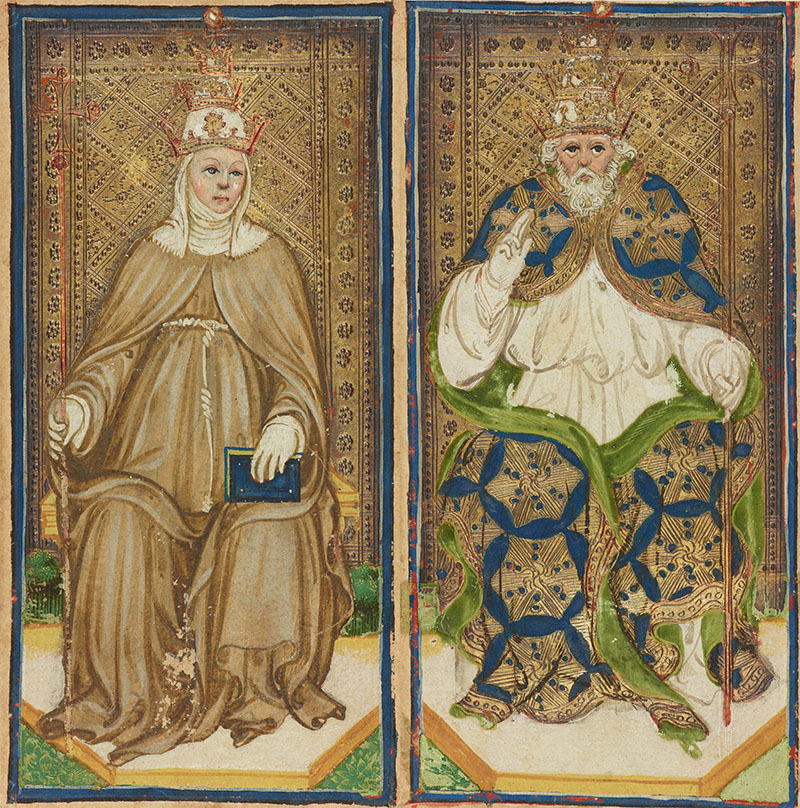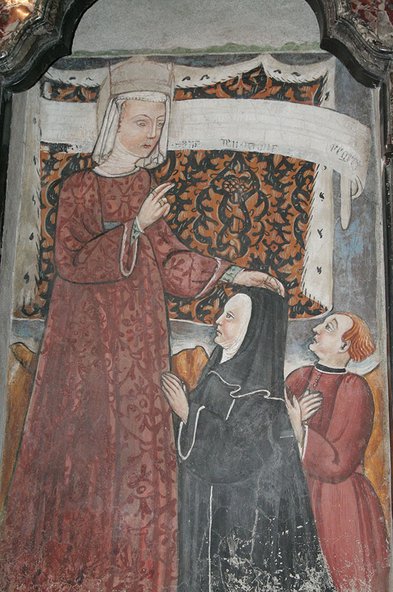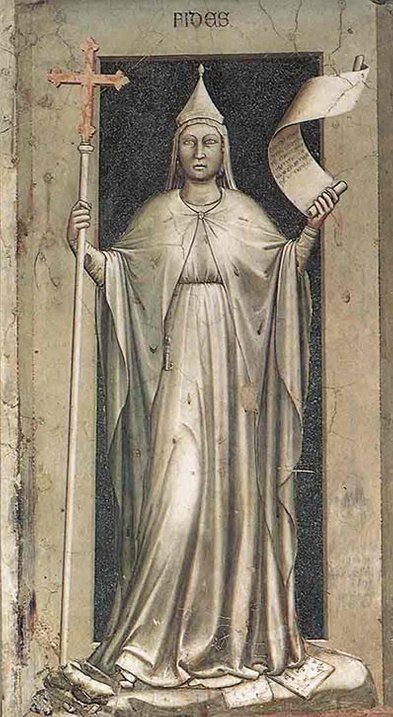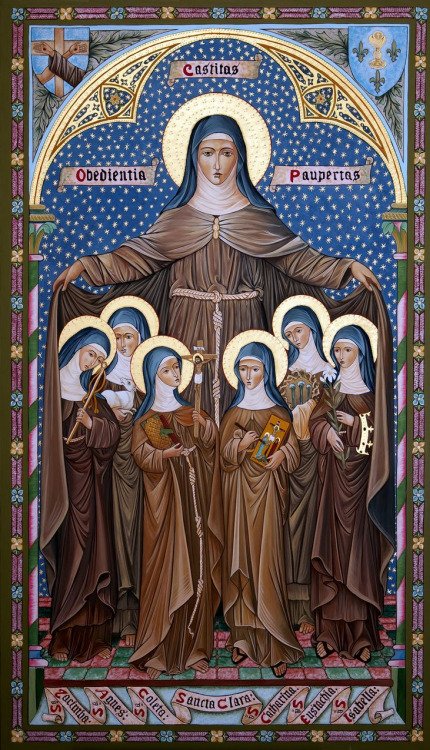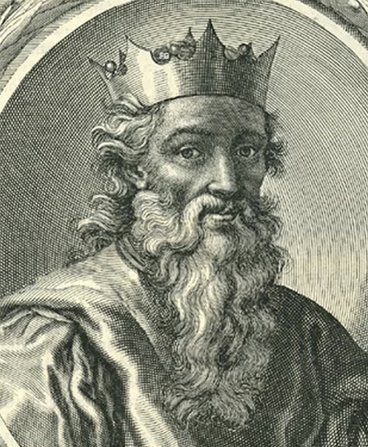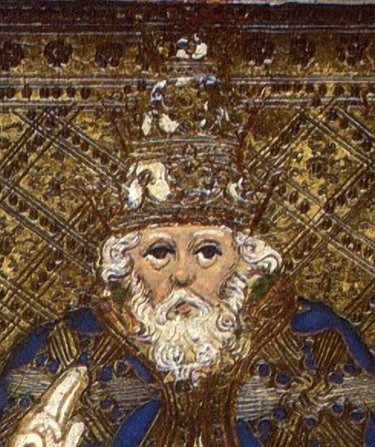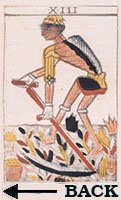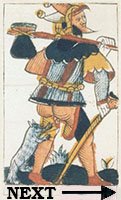THE TAROT WHEEL
The Third Estate of the Realm is the clergy. Just as the Second Realm was represented by its highest leaders, also the clergy should be represented by its highest leaders. The general structure of the fourteen trump cards had been fixed, but there were still big problems to solve. The first difficulty was the figure of the Pope himself. The Visconti family conflicted with the Popes for many generations. Matteo I Visconti, was twice excommunicated by Pope John XXII, in 1317 and in 1322, the second time together with his sons. Two generations later, Bernabo Visconti was excommunicated, in 1360 by Pope Innocent VI. In 1363 Pope Urban V excommunicated Bernabo again together with all his children. In 1373 Pope Gregory IX excommunicated Bernabo Visconti for a third time, now together with his brother Galeazzo, both great-grandfathers of Bianca Maria Visconti. The bad relationship between her father and Pope Eugene IV, who had been Pope between 1431 and 1447, at the dawn of the Trionfi decks, must have had a great influence on the young Bianca Maria. Even being a very religious woman, she was certainly not charmed by the idea to represent the Clergy on the Trionfi deck with the figure of Pope Eugene IV. Anything else was good, but not this Pope.
For the Este family this was much easier. Ferrara was part of the Papal States. Pope Eugene IV had moved the Council from Bale to Ferrara and this must have had a very positive influence on the City.
The Popess
But let us start with the Popess, one of the most intriguing cards of the Tarot. The Trionfi decks were arranged in 7 pairs of trumps so the Pope should have an evident counterpart. Pope's aren't married, so there was no equivalent for the Empress in the clergy. And putting an Abbess or a Nun next to a Pope or next to any other Priest might have given the wrong message. This was a problem for both Milan and Ferrara. We don't know how this problem was solved on the earlier Trionfi decks from Ferrara, but the Visconti Sforza deck came with a remarkable solution. Not only for the Popess, also for the Pope they found a surprising interpretation.
The father of Matteo I Visconti, Teobaldo Visconti (not to confuse with Tebaldo Visconti who became Pope in the same period), was married with Anastasia da Pirovano. Anastasia was a sister of Morando da Pirovano, father of Maifreda da Pirovano. Maifreda was a nun in the Humiliata order, and she became a follower of Guglielma of Boëma, as the legend says a daughter of King Ottocar I of Bohemia. Guglielma came to Milan short after 1260. She was very opposed to the luxurious life of the Church leaders. She adopted the life of a pinzochera, a woman who lived independently in her own home and devoted here whole life to God and to praying. Furthermore, she became famous by the religious ideas she preached against the corrupt Church and by her healing powers. According to Guglielma, the Church had to go back to the source, to religion itself. She found a very fertile ground in Milan that was traditionally opposed to the Pope, and many very influential Milanese upper-class citizens became Guglielmites, the name given to the followers of Guglieilma. Although she always rejected this, she was considered by her followers as a reincarnation of the Holy Ghost. One of her closest followers was Maifreda da Pirovano.
After the death of Guglielma in 1284, Maifreda became the new leader of the Guglielmites. She was finally elected Popess by the Guglielmites, and like Guglielma, she was very devoted to religion itself. As Popess, she nominated cardinals and celebrated the Holy Mess over the grave of St Guglielma. The Roman Catholic Church could not tolerate this, and although being a first cousin of Matteo I Visconti, Lord of Milan, the Inquisition burned her, her assistant Andrea Saramita, and another nun, called Sister Giacoma dei Bassani da Nova, to the stake in 1300. Many of the so-called heretics were, in fact, much closer to the original sense of religion than the wealthy and corrupt Church leaders in Rome. To break the heretic movement, even the remains of Guglielma, who would be a Saint in other circumstances, were exhumed and burned, their ashes scattered in the winds.
Bianca Maria's Godfather, Andrea Visconti, was General in the Humiliate order, and she knew the story of Maifreda very well. She had a lot of admiration for Maifreda who was an extremely religious woman, devoting her whole life to God. Around 1450, just before the creation of the Visconti Sforza deck, Bianca Maria Visconti helped the abbess Maddalena Albrizzi to build a convent in the little village of Brunate. Bianca Maria venerated Guglielma as a Saint and in the chapel of this convent we see a fresco depicting Santa Guglielma who is blessing a nun and a man. According to some sources this nun could be sister Maifreda and the man his follower Andrea Saramita. Other sources say that the nun is Maddalena Albrizzi herself. It seems very unlikely that a nun would have her own image painted, so the thesis that the nun would be sister Maifreda might be plausible.
With the story of Guglielma and Maifreda fresh in her mind, Bianca Maria maybe played with the idea of having Faith replaced with her faithful relative Maifreda. On the card with the Popess we see a woman in the simple clothes of a nun. Here face radiates peace. She has a closed book in her left hand, a symbol often used to indicate a person who has passed away (her life is a closed book). The woman on the card beliefs profoundly in God and she has an absolute Faith in Him. The resemblance of the Popess in the Visconti Sforza with Faith as painted by Giotto is remarkable (here at the left). Replacing the Popess by a personification of Maifreda might be plausible for the Visconti Sforza deck, but it certainly not an acceptable figure on other Trionfi decks. Regretful for us, the Visconti Sforza is the only well-known hand-painted deck that gives us an original image of a female Pope (La Papessa). The Popess should rather be a Saint or close to it.
If the Tarot was an invention of the Visconti, I could possibly believe that the original Popess was created after the image of Maifreda da Pirovano, in this theory, but they didn't invent the structure. Certainly, the Visconti have played a big role in the Tarot history, but if the Visconti were the driving force behind the Trionfi deck, the 5 times 16 structure of the Visconti di Modrone would have dominated. And remember, in this structure there is no Popess. Instead of the Popess we see Faith, and instead of the Pope, there is Hope. After Filippo Maria Visconti died, the Milanese Trionfi decks finally started to use the “standard” structure, as it was produced already over ten years in Ferrara and Florence. In this "standard" structure, we have 5 suits of 14 cards and in the trump suit we find a Popess and a Pope. The Milanese ducal family had to fit this structure to their own history. Even if Bianca venerated Maifreda, using a woman who was considered a heretic, and ended burned to the stake was maybe not the best idea. How to solve this question?
On the older Visconti decks, we see a strong Emperor, looking directly in our eyes. He represents probably the last Emperor Sigismundo, who had died in 1437. On the Visconti Sforza deck the Emperor is an old man, and this is strange enough our first hint to the figure of the Popess. If we lay the cards in order from left to right, instead of looking to us, as in the Visconti di Modrone, or to the Empress, as in the Tarot of Marseille, he is looking to the Popess who triumphs over him. This is the second hint. The Popess is sitting on a wooden seat, with a book in her left hand (right for us) and a cross in the other one, the third hint. Her habit is brown, like the habit of a nun, the fourth hint. On her head the papal Tiara. She is looking slightly down to our right. On her waist, she has a cord keeping her habit together. In the cord, we see several knots. And this is the fifth hint.
Especially the last hints are important. Some people identify the habits as those of the nuns of the Umiliati order. This identification is rather a wish in order to make the link to Maifreda da Pirovano. What gives us a real clue about the order of nuns is the knotted rope of the Popess. This attribute is only used by Franciscan monks and related orders like the Poor Clares, an order created by St Clare of Assisi, a follower of St Francis of Assisi. On the picture to the right we see St Clara in a brown nuns habit with the knotted Franciscan cord around her waist, everything exactly exactly like the Popess. The nuns of the order of the Poor Clares below here are carrying several attributes, like the Book (New Testament) and the Cross. Definitely we can Identify the Popess as being a Poor Clares nun or even St Clare of Assisi herself.
But why would Bianca Maria Visconti use a nun of the order of the Poor Clares (or St Clare herself) as the Popess? The answer is more evident than one would suppose. On the illustration, the second nun from the left is called Saint Agnes. She is nobody less than Agnes of Bohemia, one of the youngest children of King Ottocar I of Bohemia and one year younger than her sister Guglielma. If Guglielma of Milan really was the daughter of Ottokar I, then Saint Agnes would be her full sister.
In any case, true or not, Bianca Maria believed firmly in this thesis and this was reason enough to portray Agnes as the Popess. When Agnes was only 8 years old, she was engaged to Henri, King of Germany and son of Frederic II, Emperor of the Holy Roman Empire. But things do not always proceed as planned, and six years later, Henri was married to someone else. A war was the result, and then Ottokar I wanted to marry his daughter to King Henry III of England. This was refused by the Emperor, who wanted the young woman himself as a spouse. Sick of all these arrangements, Agnes refused this marriage and decided to devote her life to prayer and to God.
And here we find the answers to the other hints. Emperor Frederic II was 27 years older than Agnes, for her, he was an old man. Agnes refused to obey to the will of the Emperor to marry her. She followed her own will and became a nun. Agnes heard talking about Clare of Assisi, and began to correspond with her. Thanks to their correspondence, Clare send five nuns to Prague, where they started the first Poor Clare community north of the Alps. In 1236, she entered as a nun in this order, and one year later she became the Abbess of the Prague Poor Clares. She stayed Abbess in this community for 45 years, until the date she died, one year after the death of her supposed sister Guglielma.
Because of her refusal to marry the Emperor, Agnes triumphed over him. Given the Poor Clare cord around the waist of the Popess, Agnes of Bohemia is the perfect candidate for personalizing the Popess. While Guglielma was considered a heretic by the Church, Agnes was venerated as a Saint. Showing Agnes of Bohemia as the Popess, the deck recalls the story of Maifreda. So If the Visconti Sforza deck does not represent Maifreda di Pirovano as the Popess, at least it recalls the story of their relative who preferred prayer and poorness on Earth over the wealth and sins of the Church leaders.
The Pope
Like the Popess, portraying the Pope posed a problem for a member of the Visconti family, who were fervent Ghibellines, and declared opponents of the Pope. The Visconti family had produced a Pope, Gregory X, who was born as Theobaldo Visconti. Some people say he was a far cousin of Matteo I Visconti, others think that the same family name is just a coincidence. In any case, it would be difficult to link the card portraying the Pope to Gregory X, who was by the way Pope, when Gullielma was preaching in Milan.
But in 1451 something happened that made the decision of Bianca Maria and her husband much easier whom to have portrayed on the Pope card. On the 7th of January 1451, Amadeux VIII, father-in-law of Filippo Maria Visconti and step-grandfather of Bianca Maria, dies. During 10 years of his life, Amadeus VIII had been better known as Pope Felix V. He was officially nominated Pope by the Council of Bale who was in opposition to Pope Eugene IV, who refused the authority of this Council. After the death of Pope Eugene IV, Pope Felix V abdicated in favor of the newly elected Roman Pope, Nicolas V. His death made the way clear to portray Felix V as Pope in the Visconti Sforza deck. Portraying Felix V instead of Eugene IV was a natural thing for a Ghibelline family like the Visconti. Felix V on the cards offered Bianca Maria the opportunity to explain to her children the problems their ancestors (and especially her father Filippo Maria Visconti, who was a son-in-law of Amadeux VIII alias Felix V) had with the Popes of Rome.
The card of the Pope on the Visconti Sforza deck, shows an old bearded man sitting on a throne and blessing us. In showing the Pope as an old man with a beard (no Popes in that period had a beard), this card further symbolized the decline of the Roman Catholic Church. This negative vision of the Church is confirmed some years later by four criminal and corrupt Popes, who occupied the Papal Seat from 1484 to 1521 (successively Innocent VIII, Alexander VI, Julius II and Leo X). These four not so Holy Popes, were the main reason for the Reformation in Europe.
At the left a portrait of Duke Amadeus VIII and at the right detail of the Pope card on the Visconti Sforza deck. None of the popes in the 15th Century have ever been portrayed with a beard. Amadeus VIII is often illustrated as having a long beard. Even his curly hair looks a lot like the hair of the Pope. Remark also that the suit of the Pope is decorated with a Visconti device, the radiant sun, that sometimes indicates an ally, and sometimes someone dependent upon Milan. Here its seems to be an Ally, Pope Felix V. Considering the preceding, this might be true. On one side, Felix V on this card, honors Amadeus VIII, who died recently and who was not only a very close ally of the Visconti family, but also step-grandfather of Bianca Maria. On the other side, in portraying an anti-Pope, the Duke and Duchess of Milan express their opposition with the Pope of Rome.
In summary, the Popess symbolizes Religion in its true form, and the Pope the declining Roman Catholic Church. Religion trumps over the Emperor because the Emperor is only temporal, and Religion will exist as long as humanity exists. The Pope trumps over the Popess because it is the Church that defines the rules that everybody has to follow to have a chance to go to Heaven. Once you break these rules, you are, as Sister Maifreda, even being deeply religious, considered a heretic and burned to a stake by the Inquisition.
PAIR 3 - THE CLERGY
